My surprise announcement to Mary that we’d be spending two days touring the gorgeous Hunter Valley region and staying in romantic accommodation was met with a loving smile. It was much better than the death rays from her eyes I would have received had I added the part about the trip being undertaken on a motorcycle. Being a rider herself, it had been years since she’d had been a pillion. Her passion for riding had also faded as our family grew.
But as it turned out, Yamaha’s MT-09 Tracer delivered an experience good enough to keep me well out of the dog house and reignite Mary’s passion for two-wheeled touring. Based on this alone, the Tracer is set to be a big player in the sports-touring market this year – especially for lovers of two-up riding.
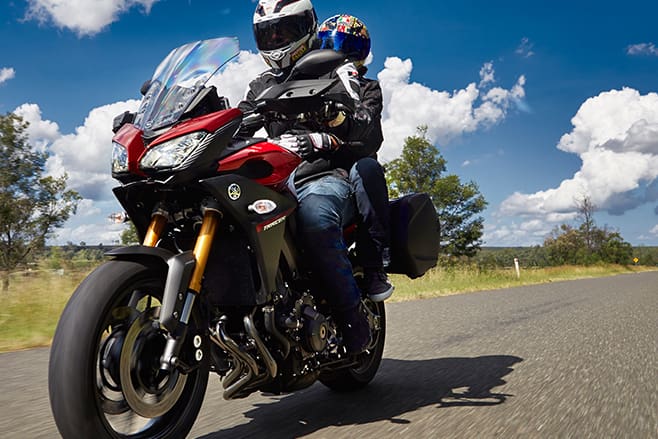
Prior to sampling Yamaha’s MT-09 Tracer, it would have been easy for me to view it simply as an MT-09 with a comfortable seat and a windscreen. Not that such a machine would be a bad thing. The naked triple-cylinder is a cracking, torque blessed, nimble urban brawler. However, the Tracer is so much more than that. And it’s not until you rack up some decent mileage on the middleweight mile cruncher that you really appreciate just how well suited to the task the MT-09 platform is. It’s also very attractively priced. At just $13,990 (+ ORC), the Tracer is setting a new value for money benchmark in the sports-tourer segment.
While the Tracer bares a physical resemblance to its MT-09 sibling, from the rider’s seat it feels completely different. For a start, the seat is longer and wider. It also sits 30-45mm higher than MT-09, depending on what setting you have the adjustable seat on. The wider tapered handlebar is also much higher and closer to the rider. This change comes courtesy of the handebar’s shape and adjustable mounting brackets.
Despite the footpeg position remaining unaltered, the riding position has been shifted into a much more upright and comfortable position – assisted by the adjustable ergonomics (see sidebar). Other noticeable changes include the multi-layer fairing with height-adjustable LED headlights, adjustable screen, larger 18-litre petrol tank (up from 14 litres) and the same LCD dash as the one fitted to Yamaha’s Super Ténéré. The fairing has been stylishly integrated to suit the bike’s lines and does away with the MT-09’s famous Gecko-biting-a-motorcycle design.
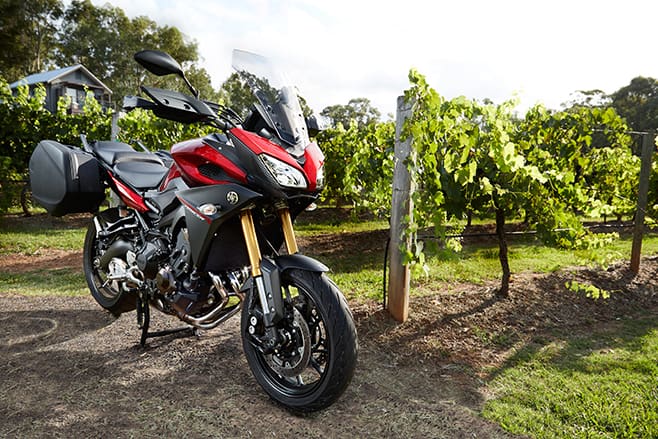
The purpose of the two-day road trip to the Hunter Valley wasn’t only to familiarise myself with Yamaha’s latest offering, but to put the Tracer to the test as a two-up adventure machine.
With more couples beginning to enjoy the freedom two wheels offers, Yamaha is keen to capture the two-up market and has designed the Tracer with the pillion in mind.
The standard MT-09 subframe has been replaced with a longer and wider unit, allowing for the fitment of a longer and wider pillion seat. The adjustable rider seat has also been reshaped and enlarged for a more comfortable ride.
Luckily for me, Mary found the seat and peg position very much to her liking when she got on the bike. Advising me of her comfort was at least acknowledging my presence. More elaborate communication was still someway off – evident in her refusal to turn on the helmet intercom.
Tailored Tracer
The upright tapered handlebar can be moved forwards or rearwards 10mm – by simply reversing the mounting bracket. The handlebar itself rotates back and forth in the mounting brackets. There’s even a couple of spare bolt holes positioned underneath the top mounting brackets for installation of a GPS unit and other accessories – which can be powered from the 12V power outlet.
The rider’s seat can also be set at two different heights (845mm and 860mm) independent of the pillion seat. An optional lowering kit can take the seat all the way down to 815mm. The screen can also be adjusted up and down 30mm – via a release mechanism located between the two headlights.
Appearing unfazed by Mary’s silent treatment, but secretly fearing for my safety, I set the adjustable screen to the lowest of three settings, via the two adjustment knobs behind the dash to maximise the cooling breeze. I checked the easy-to-adjust seat height was acceptable and prepared to depart.

The Australian-delivered Tracer is fitted with 19.5-litre hard panniers as standard. It’s a smart move by Yamaha Australia: not only do the panniers further set the bike apart from its sibling by making it look more like an adventure bike, they’re large enough to carry the basic necessities for an overnighter – as well as wet weather gear.
The easy-to-remove panniers can only be opened and closed with a key, which proved to be a little frustrating when wanting to quickly access phones or wallets. But on the upside at least you know they’re always locked. With my concerns over Mary’s comfort sorted, there was just the niggling worry about the Tracer’s three-cylinder powerplant. Don’t get me wrong, Yamahas 847cc CP3 engine is a brilliant unit that will undoubtable appear in an increasing number of Yamaha products.
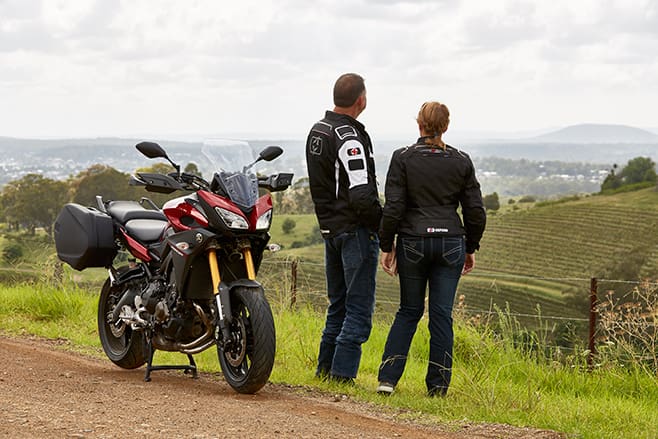
But after sampling the torque-packed three-pot on several occasions, I can only describe the fuelling as slightly snatchy. Awesome fun if you’re riding solo – revelling in the instant throttle response – but possibly not so much fun when wanting a super-smooth two-up ride.
As it turned out, my fears were unfounded. The engine performed as if it were designed specifically for the task of two-up riding. Flicking through the engine mapping selections of A, Standard and B revealed B to be a slightly sluggish on the take-up, but still totally usable – especially in the wet. Standard is perfect for open-road riding, while A is tailor-made for the twists and turns of mountain roads.
Even two-up, the engine was eager to perform and from 4500revs upwards it scared the bejesus out of my wife. At times I was forced to reach around and tap Mary’s leg, just to make sure she had not bailed off – as after a decent squirt it felt like I was riding solo. Not a bad effort when you consider the combined weight of both riders and all our gear would have been in excess of 180kg.
Looking at the power-to-weight ratio scale, the MT-09 Tracer – with its 84.6kW (113.5hp) of power and 210kg wet weight – is comparable with a number of higher-capacity adventure machines.
At the first lunch break it became obvious Mary was enjoying herself and with all forgiven it was time to up the tempo. Yamaha has increased the compression and rebound range of the suspension on the Tracer and, with the preload on the rear shock being just three steps from its softest setting, the rear end supported our combined weight within the sweet point of the suspension’s travel.
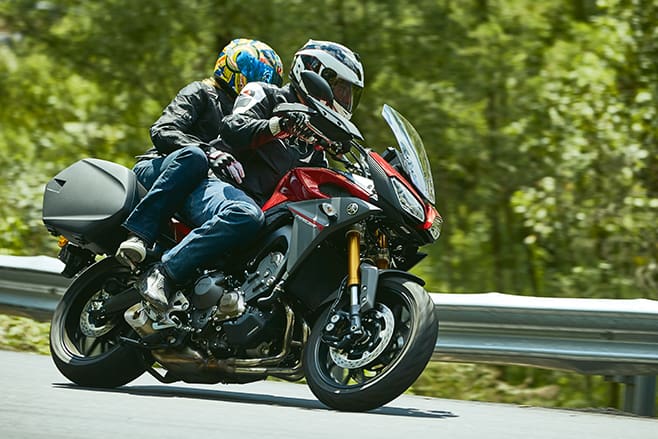
The front proved just as impressive, with a smooth linear compression on the fork under heavy braking. The only time the package fell a little short was over high-speed bumps – where the rebound felt a fraction slow, making the ride a little bumpy. It’s not a major issue and is something I’ve noticed on a number of much more expensive motorcycles.
Long fast sections of open road is where you uncover the homework Yamaha has put into the design of the fairing. The three-way adjustable screen and side-mounted air ducts allow enough wind flow to circulate around the rider without creating annoying buffeting. The lower wind deflectors also protect your legs from the elements, while the sturdy handguards are more about keeping your hands warm and dry then protecting them against low-hanging branches. Free of wind buffeting and shielded by the fairing is the best way to enjoy a two-up ride through the countryside, and the Tracer has this aspect well sorted.
Being fitted with 17-inch cast aluminium wheels makes the Tracer a true tar baby, but it’s not afraid to take on the odd dirt road. Even fitted with road tyres, the Tracer tackled damp dirt roads through the back hills of the Hunter region with ease. It was also the only time we called upon, or noticed, the traction control doing its thing. If you want a bit of tail-out action, there’s the option to disengage the traction control completely.
Yamaha’s new MT-09 Tracer is based on the company’s top-selling triple-cylinder MT-09 nakedbike, but the designers have done much more than just slap on a windscreen and panniers. Here’s all the extras:
1. Height-adjustable windscreen 2. New LED lights 3. Centrestand 4. Longer hero knobs to protect centrestand 5. Redesigned exhaust tucked neatly under the centrestand 6. 19.5-litre hard panniers fitted as standard 7. Subframe 130mm longer than MT-09 for larger pillion seat 8. Longer height-adjustable main seat and wider pillion seat 9. Larger capacity 18-litre fuel tank (up from 14 litres) 10. 12-volt power outlet 11. Multifunctional instrument panel: same as the Super Ténéré 12. Adjustable handlebar 13. Upgraded fork and rear shock(for compression and rebound) 14. Multi-element nose fairing.
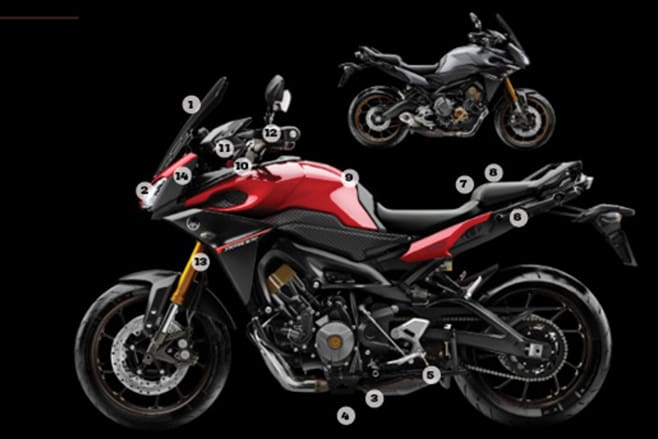
The Tracer is an ideal size: big enough for comfort and small enough for manoeuvrability. If you were to accidentally drop it, lifting it back upright would be a one man\woman job. It handles every bit as well as its MT-09 brother, possibly even more so at low or mid-range speeds, thanks to the wider ’bars and more upright seating position. The bike returned a fuel economy figure of 4.6L/100km, so 300km from a single tank of fuel is achievable. There was a time when mid-capacity adventure motorcycles were seen as the not-bad-but-not-as-good alternative to the big-capacity, tech-laden globe bashers.
But in recent years common sense has prevailed, and a growing number of adventure riders, both on and off-road, are turning to mid-capacity long haulers due to their real world practicality. While the Triumph Tiger XC and BMW F800 led the way with their multi-purpose design, the Tracer takes the idea and leans it more toward a purpose bitumen adventure bike, with sports DNA. There’s no reason why a Tracer owner couldn’t commute to work through city traffic Monday to Friday, then chase sportsbike-mounted mates through the twisties on Saturday and leave them behind on a long-range Sunday tour.
With that low price tag of just $13,990, married men across the country should be especially keen to buy their beloved a bunch of flowers, hang out the washing and get the kids off to school while she has a much-deserved sleep-in.
And when she wakes from her restful slumber, tell her about a married couple you read about who’ve loved the freedom of weekend escapes on a Yamaha Tracer. When she predictably tells you it’s not an affordable option, tell her she’s right: $20,000 is too much. Wait two more days, then astound here with the news the Tracer is a sub $14,000 bike. As I said, it’s not what you say – but the order you say it in.
Happy wife, happy life.

This article appears in AMCN Vol 64 No 18











